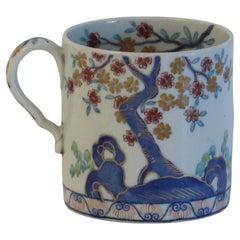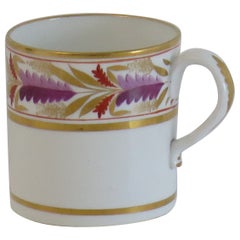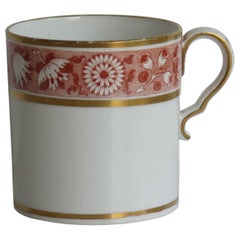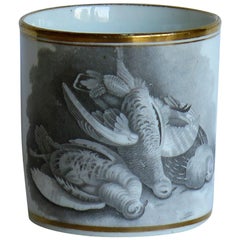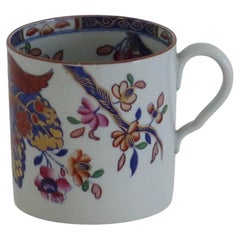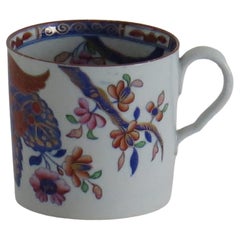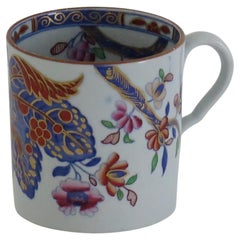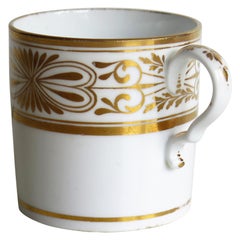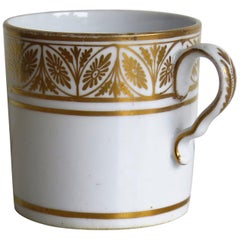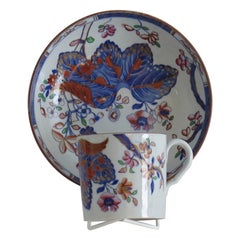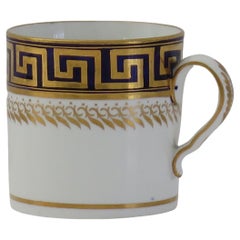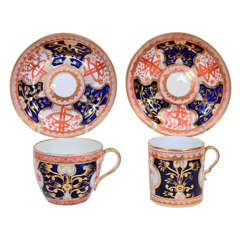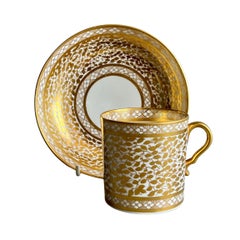Spode Coffee Can
Antique Early 19th Century English Georgian Ceramics
Ironstone
Antique Early 19th Century English George III Ceramics
Porcelain
Antique Early 19th Century English George III Ceramics
Porcelain
Antique Early 19th Century English Georgian Ceramics
Porcelain
Antique Early 19th Century English Chinoiserie Ceramics
Ironstone
Antique Early 19th Century English Chinoiserie Ceramics
Ironstone
Antique Early 19th Century English Chinoiserie Ceramics
Ironstone
Antique Early 19th Century English Regency Ceramics
Porcelain
Antique Early 19th Century English Regency Ceramics
Porcelain
Antique Early 19th Century English Chinoiserie Ceramics
Ironstone
Antique Early 19th Century English George III Ceramics
Porcelain
Recent Sales
Antique Early 19th Century English Regency Porcelain
Porcelain
Antique Early 1800s English George III Porcelain
Porcelain
Antique Early 1800s English Neoclassical Porcelain
Porcelain
Antique Early 19th Century English Chinoiserie Ceramics
Ironstone
Antique Early 1800s English George III Porcelain
Porcelain
Antique Early 19th Century English Regency Tea Sets
Porcelain
Antique Early 19th Century English George III Porcelain
Porcelain
Antique Early 19th Century English Georgian Ceramics
Ironstone
Antique Early 19th Century English George III Ceramics
Porcelain
Antique Mid-19th Century English Chinoiserie Ceramics
Ceramic
Antique Early 19th Century English Chinoiserie Porcelain
Porcelain
Antique Early 19th Century English George III Ceramics
Porcelain
Antique Early 19th Century English Georgian Ceramics
Porcelain
Antique Early 19th Century English George III Ceramics
Porcelain
Antique Early 19th Century English George III Ceramics
Porcelain
Antique Early 19th Century English Regency Porcelain
Porcelain
Antique Early 19th Century English George III Ceramics
Porcelain
Antique Early 19th Century English George III Ceramics
Porcelain
Antique Early 19th Century English Georgian Ceramics
Porcelain
Antique Early 19th Century English Georgian Ceramics
Ironstone
Antique Early 1800s English Regency Porcelain
Porcelain
Antique Early 19th Century English George III Tea Sets
Porcelain
Antique Early 19th Century English George III Ceramics
Porcelain
Antique Early 19th Century English Georgian Ceramics
Ironstone
Antique Early 19th Century English Chinoiserie Ceramics
Ironstone
Antique Early 19th Century English Chinoiserie Ceramics
Ironstone
Antique Early 19th Century English George III Ceramics
Porcelain
Antique 1810s English Georgian Ceramics
Ceramic
Antique Mid-19th Century English Chinoiserie Ceramics
Porcelain
Antique Mid-19th Century English Chinoiserie Ceramics
Porcelain
Antique 19th Century English Tableware
Antique 1810s English Georgian Porcelain
Porcelain
Antique 1810s English Georgian Porcelain
Porcelain
People Also Browsed
Antique Early 19th Century English George III Ceramics
Porcelain
Antique 19th Century English Chinese Chippendale Vitrines
Glass, Mahogany
Antique 19th Century Porcelain
Porcelain
Antique Mid-19th Century English High Victorian Taxidermy
Other
Antique Late 18th Century English Chinoiserie Ceramics
Earthenware
Vintage 1950s French Rococo Tea Sets
Porcelain
Antique 19th Century British Porcelain
Porcelain
Antique Early 19th Century English George III Ceramics
Porcelain
Antique 1880s English Chinoiserie Porcelain
Porcelain
Antique Late 19th Century French Belle Époque Planters, Cachepots and Ja...
Porcelain
Antique Mid-19th Century English Chinoiserie Ceramics
Pottery
Antique Early 1800s British Neoclassical Dinner Plates
Pearlware
Antique Early 19th Century English Chinoiserie Ceramics
Ironstone
Antique Mid-19th Century English Chinoiserie Pottery
Pottery
Antique Early 19th Century English George III Ceramics
Porcelain
Antique 1820s English Regency Porcelain
Porcelain
Spode Coffee Can For Sale on 1stDibs
How Much is a Spode Coffee Can?
Finding the Right Porcelain for You
Today you’re likely to bring out your antique and vintage porcelain in order to dress up your dining table for a special meal.
Porcelain, a durable and nonporous kind of pottery made from clay and stone, was first made in China and spread across the world owing to the trade routes to the Far East established by Dutch and Portuguese merchants. Given its origin, English speakers called porcelain “fine china,” an expression you still might hear today. "Fine" indeed — for over a thousand years, it has been a highly sought-after material.
Meissen Porcelain, one of the first factories to create real porcelain outside Asia, popularized figurine centerpieces during the 18th century in Germany, while works by Capodimonte, a porcelain factory in Italy, are synonymous with flowers and notoriously hard to come by. Modern porcelain houses such as Maison Fragile of Limoges, France — long a hub of private porcelain manufacturing — keep the city’s long tradition alive while collaborating with venturesome contemporary artists such as illustrator Jean-Michel Tixier.
Porcelain is not totally clumsy-guest-proof, but it is surprisingly durable and easy to clean. Its low permeability and hardness have rendered porcelain wares a staple in kitchens and dining rooms as well as a common material for bathroom sinks and dental veneers. While it is tempting to store your porcelain behind closed glass cabinet doors and reserve it only for display, your porcelain dinner plates and serving platters can safely weather the “dangers” of the dining room and be used during meals.
Add different textures and colors to your table with dinner plates and pitchers of ceramic and silver or a porcelain lidded tureen, a serving dish with side handles that is often used for soups. Although porcelain and ceramic are both made in a kiln, porcelain is made with more refined clay and is stronger than ceramic because it is denser.
On 1stDibs, browse an expansive collection of antique and vintage porcelain made in a variety of styles, including Regency, Scandinavian modern and other examples produced during the mid-century era, plus Rococo, which found its inspiration in nature and saw potters crafting animal figurines and integrating organic motifs such as floral patterns in their work.
- How old is Spode?1 Answer1stDibs ExpertApril 5, 2022Spode pottery dates back to the 1770s and the originator of the company, Josiah Spode. Josiah Spode was born in 1733 and learned the trade by working for other local potters until 1775 when he established his own company. Find a collection of expertly vetted Spode pottery from some of the world’s top sellers on 1stDibs.
- What is Spode Copeland?1 Answer1stDibs ExpertApril 5, 2022Spode Copeland is a brand of fine antique porcelain from Britain. The Spode company started in 1776, and was bought by the Copeland family early in the 1830s. Browse a collection of Spode Copeland porcelain pieces from top sellers on 1stDibs.
- 1stDibs ExpertAugust 20, 2024To tell if a Spode is vintage, do some research using trusted online resources. Start by comparing the brand mark on your piece to images shared online to get a rough idea of the timeframe during which it was produced. From there, you can look at catalogues and references to identify the pattern and get a clearer picture of its manufacturing date. If your piece was made 20 to 99 years ago, it is vintage. Older pieces are antiques, while newer ones are contemporary. Should you run into any difficulty, a certified appraiser or knowledgeable dealer can help you with the dating process. Explore a collection of Spode pottery on 1stDibs.
- 1stDibs ExpertApril 16, 2024Most Spode is bone china. During its early decades, Spode was the first to develop a standard formula for the making of bone china, and most of its pieces made after this innovation are examples of bone china. However, particularly early on, Spode did make other types of pottery, such as earthenware. On 1stDibs, shop a selection of Spode china.
- Is Spode china still being made?1 Answer1stDibs ExpertApril 5, 2022Yes, Spode pottery and homewares are still being made. Spode is an English brand founded by Josiah Spode and is credited for perfecting the techniques that were crucial to the future success of English pottery. Spode pottery can be purchased through authorized retailers, such as 1stDibs.
- 1stDibs ExpertApril 22, 2024Whether you can put Spode china in the dishwasher varies. Some pieces are dishwasher-safe and will be marked as such on their backs or bottoms. Other pieces cannot be safely placed in the dishwasher. If your Spode china doesn't have a dishwasher-safe marking, err on the side of caution and hand wash it only. On 1stDibs, find an assortment of Spode china.
- Is Spode pottery worth anything?1 Answer1stDibs ExpertNovember 20, 2024Yes, some Spode pottery is worth something. Spode is one of the oldest and most distinguished of the great pottery companies of Staffordshire, the time-honored home of English ceramics. The firm’s blue and white bone china transferware is a timeless classic. Spode dishes compose the sort of elegant dinner service that most of us envision on a traditional holiday table, and as a result, pieces produced by the maker are often in high demand. Potential selling prices of Spode pottery vary based on type, style, pattern, age, condition and other factors. If you'd like to know how much items in your collection may be worth, consider using the services of a certified appraiser or knowledgeable antique dealer. On 1stDibs, shop a range of Spode pottery.
- 1stDibs ExpertAugust 15, 2024Whether Spode is made in England or China depends on the piece. Spode continues to manufacture some of its iconic china at its workshop in Stoke-on-Trent, England, which has been in continuous operation for more than 250 years. However, some lines now originate from factories in China that adhere to the brand's strict quality standards. On 1stDibs, shop a wide variety of Spode pieces.
- 1stDibs ExpertMarch 13, 2024Whether Spode Christmas dishes can go in the microwave varies. Many of the British maker's dinnerware is dishwasher-safe as well as microwave- and freezer-safe, but not all its pieces are. As a result, you should look at the markings on the bottom of your dishes and consult the care instructions that accompany them for advice on how to safely use them. Find a large selection of Spode porcelain and ceramic wares on 1stDibs.
- 1stDibs ExpertAugust 8, 2024No, Spode Christmas Tree is not still made in England. In 2006, the British maker began producing its iconic holiday china in Malaysia. Pieces made prior to 2006 originated at the company's workshop in Stoke-on-Trent, England. On 1stDibs, find a variety of Spode china from some of the world's top sellers.
- Why is it called a coffee table?1 Answer1stDibs ExpertAugust 15, 2019
Coffee tables were originally used in living spaces during social gatherings to support a tray containing multiple mugs, a coffee pot, creamers and sugar bowls. Low to the ground and centrally located in the space, coffee tables reduced the host or hostess’s need to constantly stand and serve her guests.
- 1stDibs ExpertSeptember 25, 2019
A coffee table should generally be two-thirds as long as the sofa it stands in front of and around the same height as the sofa’s seat cushions.
- Is an ottoman a coffee table?1 Answer1stDibs ExpertApril 5, 2022Typically, an ottoman is not a coffee table. An ottoman is a small cushioned seat without a back or arm rests. You can shop a collection of vintage and contemporary ottomans from some of the world’s top sellers on 1stDibs.
- Can a coffee table be too low?1 Answer1stDibs ExpertAugust 8, 2024Yes, a coffee table can be too low. Most experts recommend choosing a coffee table that is around one to two inches lower than the seat height of your sofa or loveseat. You may find it difficult to access items on the tabletop while seated if you choose a shorter table. In addition, an overly low coffee table can make a room feel cramped or unbalanced. However, there are exceptions to this rule. Sometimes, designers intentionally place ultra-low coffee tables in spaces to create a bold contrast in a large room. Feel free to break from convention when choosing a coffee table. What's most important is that the finished result appeals to you and allows you to enjoy your seating area to the fullest. Shop a wide range of antique, vintage and contemporary coffee tables on 1stDibs.
- Who invented the coffee table?1 Answer1stDibs ExpertApril 12, 2024No one knows for sure who invented the coffee table. The earliest examples of the occasional table can be traced back to Victorian-era Britain. At that time, makers like William Watt and Collinson and Lock were producing coffee tables in large quantities.
Notably, F. Stuart Foote, the designer behind the American Imperial Furniture Company, claimed to have invented the coffee table in the early 20th century. He stated that he did so by cutting down the legs of a dining table. However, it's unlikely that Foote is the actual inventor of the coffee table, as books describing coffee tables existed in the UK a decade before his birth in 1872.
Shop a wide variety of coffee tables on 1stDibs. - What are the best coffee makers?1 Answer1stDibs ExpertFebruary 22, 2021The best coffee makers really come down to preference. on 1stDibs, you can find a variety of Georgian, Victorian, Art Deco, Regency, and mid-century modern coffee makers that will fit your style preference.
- 1stDibs ExpertMay 30, 2024There isn't really a standard size of a coffee table. Manufacturers produce coffee tables in a range of sizes and shapes. However, many rectangular tables are around 45 to 48 inches in length by 25 to 28 inches in width. Heights typically range from 16 to 18 inches. Shop a wide variety of coffee tables on 1stDibs.
- What is a tray top coffee table?1 Answer1stDibs ExpertOctober 26, 2021Tray top coffee tables are coffee tables with long, flat rectangular surfaces that are supported by an x-frame base. Low tables that were initially used as tea or coffee tables have been around since at least the mid- to late-1800s. After coffee drinking and “coffee breaks” became popular, it didn’t take long for coffee and cocktail tables to become a design staple and for consumers to recognize their role in entertaining no matter what beverages were being served. Shop a collection of antique, vintage, and contemporary tray top coffee tables from some of the world’s top dealers on 1stDibs.
- Are copper coffee pots safe?1 Answer1stDibs ExpertApril 5, 2022Opinions on whether or not copper coffee pots are safe vary. Some experts raise concerns over the use of copper vessels and recommend that you only use ones lined with another metal like tin or aluminum. As a result, people may choose to use antique pots only as decorative objects. Shop a range of antique copper coffee pots on 1stDibs.
- 1stDibs ExpertMay 5, 2023To style an oval coffee table, create balance with opposites. Choose a sofa and accent chairs with a boxier shape for a striking contrast. Place a rectangular tray in the center and use it to display decorative accents or to store remotes and coasters. Another approach to decorating an oval table is to use decorative accents at different heights. Think of a tall vase placed next to a low bowl and a small sculpture positioned on top of two stacked coffee table books. On 1stDibs, shop an assortment of oval coffee tables.
Read More
How a Craving for Color Revolutionized Glass
After synthetic dyes changed fashion, home goods and printed matter, it was only a matter of time till glass caught up.
1882 Ltd. Looks to the Future of Ceramics in the U.K. with an Eclectic Exhibition and Auction
Faye Toogood and John Pawson are among the list of plate designers.
20 Inviting Dining Rooms Perfectly Arranged for Entertaining
Top interior designers show — and tell — us how to create delectable spaces for hosting dinner parties.
Paul Revere Crafted This Silver Coffee Pot 250 Years Ago
Perhaps best known as a Revolutionary War hero, Revere was also an accomplished silversmith, and this pot is now available on 1stDibs.
From Arne Jacobsen to Zaha Hadid, Top Designers Tackle Tableware
Clever objects like these make feasting even more festive.
How the Chunky, Funky Ceramics of 5 Mid-Century American Artists Balanced Out Slick Modernism
Get to know the innovators behind the pottery countercultural revolution.
Ready for a Cinderella Moment? This Glass Handbag Is a Perfect Fit
Glass slippers might be the stuff of fairytales, but glass handbags? Artist Joshua Raiffe has made them a reality, and they're far less delicate than you might imagine, but just as dreamy.
With Dansk, Jens Quistgaard Delivered Danish Simplicity to American Tables
When a visionary Copenhagen designer teamed up with an enterprising Long Island couple, Scandi-style magic landed in kitchens and dining rooms across the United States.
